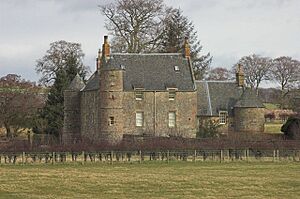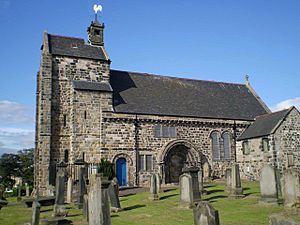John Dalrymple, 1st Earl of Stair facts for kids
Quick facts for kids
The Earl of Stair
|
|
|---|---|

John Dalrymple, 1st Earl of Stair
|
|
| Joint Secretary of State in Scotland with (1) Earl of Melville and (2) James Johnston | |
| In office 10 January 1691 – July 1695 |
|
| Monarch | Mary II & William II & III |
| Preceded by | Earl of Melville |
| Succeeded by | James Johnston |
| Lord Advocate | |
| In office 1689–1692 |
|
| Monarch | Mary II & William II & III |
| Preceded by | George Mackenzie |
| Succeeded by | Sir James Stewart |
| MP for Stranraer, Parliament of Scotland | |
| In office March 1689 – June 1702 |
|
| Monarch | Mary II & William II & III Queen Anne |
| Lord Justice Clerk | |
| In office 1688–1690 |
|
| Monarch | King James VII & II Mary II & William II & III |
| Preceded by | James Foulis, Lord Colinton |
| Succeeded by | Sir George Campbell |
| Lord Advocate | |
| In office 1687–1688 |
|
| Monarch | King James VII & II |
| Preceded by | George Mackenzie |
| Succeeded by | George Mackenzie |
| Personal details | |
| Born | 10 November 1648 Stair House, Kyle, Ayrshire Scotland |
| Died | 8 January 1707 (aged 58) Edinburgh |
| Resting place | Kirkliston, Linlithgowshire |
| Spouse | Elizabeth Dundas (c.1654–1731) |
| Children | John Dalrymple, 2nd Earl of Stair (1673-1747) William (1678-1744) George (1680-1745) Lady Margaret Dalrymple (1684-1779) Six others died young |
| Parents | James Dalrymple, Viscount Stair Margaret Kennedy nee Ross |
John Dalrymple, 1st Earl of Stair (born 10 November 1648 – died 8 January 1707) was an important Scottish politician and lawyer. He served as a top government official, known as the Secretary of State in Scotland, from 1691 to 1695. During this time, he helped put down a rebellion.
However, he had to leave his job in 1695 because of his role in the Massacre of Glencoe. Later, in 1702, he regained favor with Queen Anne and became the Earl of Stair in 1703. He was deeply involved in talks for the 1707 Acts of Union, which joined Scotland and England to create Great Britain. He died just before this important law took effect.
Contents
Early Life and Family
John Dalrymple was born in 1648 at Stair House in Kyle, Ayrshire, Scotland. He was the oldest son of James Dalrymple, Viscount Stair and Margaret Ross-Kennedy. His father, James, was a well-known lawyer.
In January 1669, John married Elizabeth Dundas. They had ten children together, but only four lived to be adults. These were John Dalrymple, 2nd Earl of Stair (who later became the 2nd Earl), Lady Margaret Dalrymple, William, and George.
A Career in Law and Politics
John Dalrymple followed his father into a career in law. His father had written a very important book about Scottish law. John became a qualified lawyer, called an Advocate, in 1672.
Political Challenges in Scotland
During the 1600s, Scotland faced many political disagreements. People argued about how much power the King should have compared to the church. After a period of conflict, the idea that the King was the highest authority became very strong. This meant that disagreeing with the King was seen as a serious political act.
In 1681, James VII & II (who would later become King) came to Edinburgh. The Scottish Parliament passed a law called the Succession Act. This law said that the King's power came from God and that the natural heir would become King, no matter their religion.
Another law, the Scottish Test Act, made public officials promise to support the Protestant religion and accept the King's power in all religious matters. However, this law did not apply to the Royal Family. This caused problems because James was Catholic.
Facing Difficulties
Many Scottish Presbyterians, including John's father, James Dalrymple, refused to take the Test Act. They felt it was unfair because the King was exempt. John Dalrymple even helped defend a nobleman, the Earl of Argyll, who was put on trial for treason for refusing the oath. Argyll was found guilty but managed to escape.
In 1682, John's father also went into exile in Holland. Because of his family's actions, John Dalrymple faced trouble. His property was used by soldiers, and his tenants were fined. John was arrested and put in prison in 1684. He was not released until 1685, after James became King.
Becoming a Secretary of State
John Dalrymple continued his political career. He became a Lord Advocate in 1687, a top legal position. Later, he served as a Lord Justice Clerk, another important legal role.
In 1691, he became a Joint Secretary of State in Scotland. This was a very powerful position, similar to a modern-day government minister. He helped the government deal with a rebellion by supporters of the old King James.
The Glencoe Incident
John Dalrymple was involved in a sad event known as the Massacre of Glencoe in 1692. This was a difficult time when the government was trying to make sure everyone swore loyalty to the new King and Queen, William and Mary.
Some clans in the Highlands were slow to take the oath. Orders were given to punish those who had not sworn loyalty. Sadly, this led to a terrible event where soldiers attacked members of the MacDonald clan in Glencoe.
John Dalrymple was one of the officials who signed the orders related to this event. Because of his part in it, he was forced to resign from his position as Secretary of State in 1695.
Working for the Union
After some years out of favor, John Dalrymple was brought back into government by Queen Anne in 1702. In 1703, he was given the title of Earl of Stair.
He played a very important role in the discussions that led to the Acts of Union in 1707. This treaty joined the Kingdom of Scotland with the Kingdom of England to form the Kingdom of Great Britain. It was a huge change for both countries.
John Dalrymple worked hard on the details of the Union, especially on how Scotland would be represented in the new British Parliament. He died on 8 January 1707, the day after a key part of the Union agreement was approved. He passed away just a few months before the Act of Union officially became law.
Legacy and Burial
John Dalrymple was buried near Edinburgh, at Kirkliston, Linlithgowshire.
After his death, his wife, Elizabeth, acquired a house in Edinburgh. This house is now known as Lady Stair's Close and House. Today, it is home to the Scottish Writer's Museum.
Sources
- [1]
- https://web.archive.org/web/20160304073250/http://www.scotlandsplaces.gov.uk/search_item/index.php?service=RCAHMS&id=111898
- http://www.capitalcollections.org.uk/index.php?a=ViewItem&i=12542
| Legal offices
|
||
|---|---|---|
| Preceded by George Mackenzie |
Lord Advocate 1687 – 1688 |
Succeeded by George Mackenzie |
| Preceded by Lord Colinton |
Lord Justice Clerk 1688 – 1690 |
Succeeded by Lord Cessnock |
| Preceded by George Mackenzie |
Lord Advocate 1689 – 1692 |
Succeeded by Sir James Stewart |
| Political offices | ||
| Preceded by Earl of Melville |
Secretary of State, Scotland 1691 – 1695 |
Succeeded by James Johnston |
| Assembly seats | ||
| Preceded by Patrick Paterson |
Burgh Commissioner for Stranraer 1689 |
Succeeded by Sir Patrick Murray |
| Peerage of Scotland | ||
| New creation | Earl of Stair 1703 – 1707 |
Succeeded by John Dalrymple |
| Preceded by James Dalrymple |
Viscount of Stair 1695 – 1707 |
|




